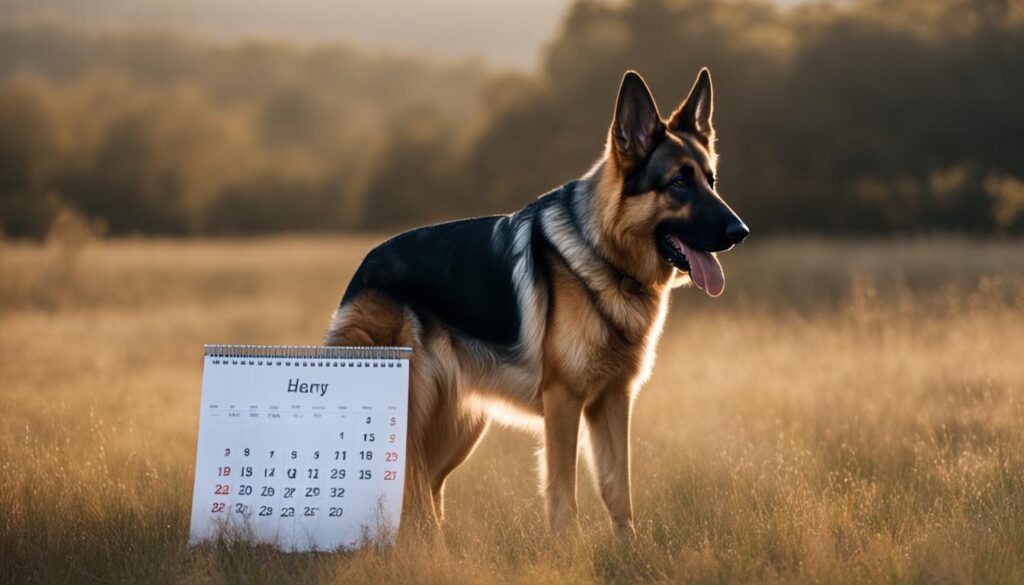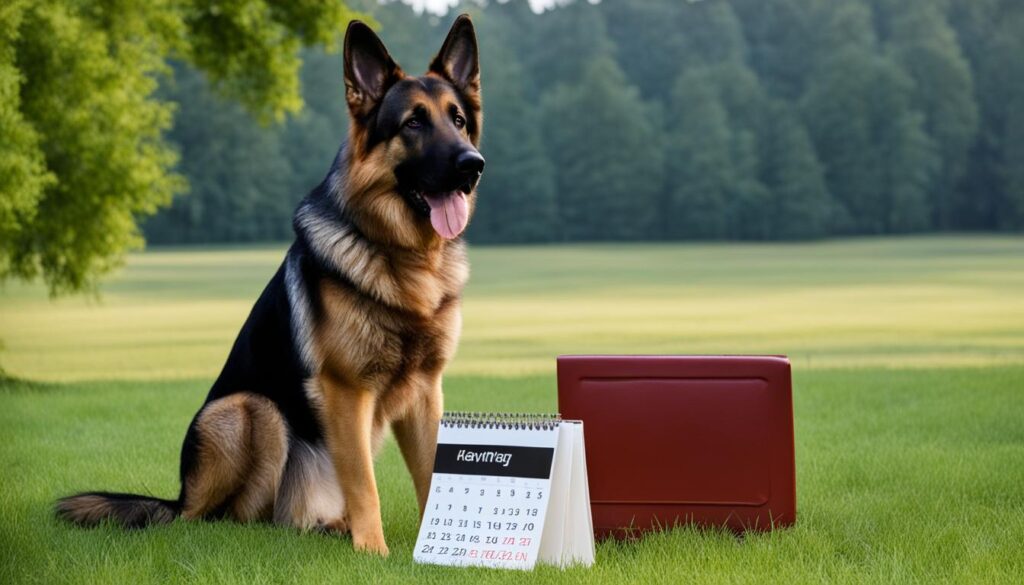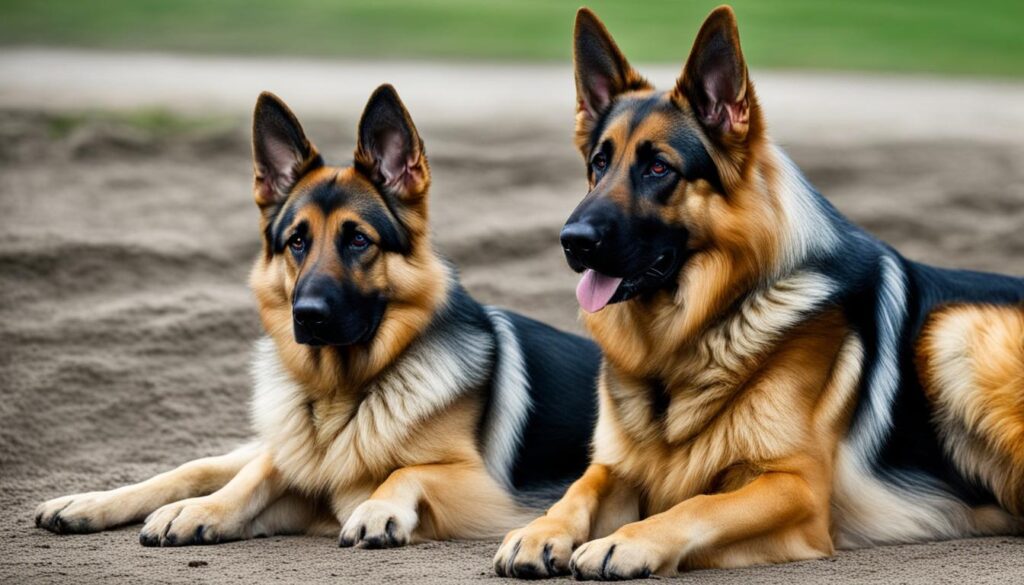Are you a proud owner of a female German Shepherd and wondering how long they will be in heat? Understanding the duration of this period is crucial for managing their behaviors and well-being during this time. In this section, we will delve into the German Shepherd’s heat cycle and explore the factors that can impact its length.
During the heat cycle, the female dog’s body prepares for possible pregnancy, which typically lasts between 2 to 4 weeks. The exact duration can vary depending on factors such as age, health, and individual variation. Therefore, it’s essential to monitor your German Shepherd closely to determine the length of their heat period.
To learn more about the factors that affect the length of a German Shepherd’s heat cycle, read on.
Key Takeaways:
- Understanding the duration of a German Shepherd’s heat cycle is essential for owners.
- Factors like age, health, and individual variation can affect the length of the heat period.
- Close monitoring of your dog’s behaviors and physical signs can help determine the duration of their heat cycle.
- It typically lasts between 2 to 4 weeks, but length may vary.
- Careful management and appropriate care can ensure your German Shepherd’s health and well-being during this time.
Factors Affecting the Length of German Shepherd’s Heat Cycle
The length of a German Shepherd’s heat cycle can vary depending on various factors. It’s crucial to understand these factors, which can affect the duration of your German Shepherd’s heat cycle so that you can be prepared for their needs and behaviors during this time.
Age
The age of your German Shepherd is a significant factor that influences the heat cycle. The first heat cycle in German Shepherds typically occurs between six and twelve months old, but it can occur later, depending on your dog’s breed, size, and environment. Younger German Shepherds tend to have shorter heat cycles, lasting for an average of 14 to 18 days. Older dogs may experience longer cycles, lasting up to 28 days.
Hormonal Imbalances
Hormonal imbalances can significantly impact your German Shepherd’s heat cycle. These imbalances arise from underlying health conditions, injuries, or infections that affect the reproductive system. Some of the conditions that can lead to hormonal imbalances include hypothyroidism, hyperadrenocorticism and ovarian abnormalities. These imbalances can cause your dog to have extended or irregular heat cycles.
Breed
The breed and its genetic makeup also play a significant role in determining the length of your German Shepherd’s heat cycle. Some breeds’ average cycle length is known to be longer or shorter than others. Average cycle length in German Shepherds is around three weeks.
These are some of the factors that can affect your German Shepherd’s heat cycle. By taking these factors into account, you can better care for your dog and help keep the transition into and out of heat as comfortable as possible for them.


Typical Duration of German Shepherd’s Heat Cycle
On average, the heat cycle of a female German Shepherd lasts around 3 weeks or 21 days. However, this duration can range from 18 to 24 days. During this period, your German Shepherd will experience different stages. The first stage, proestrus, typically lasts for 9 days and involves discharge and swelling of the vulva without fertile eggs. The second stage, estrus, lasts for 9 days and is when the fertile period occurs, and your female German Shepherd could become pregnant. The final stage, diestrus, lasts for 3 days and marks the end of the heat cycle. During this period, if your German Shepherd does not become pregnant, she will no longer show signs of heat.
It is important to note that individual variation can affect the duration of your dog’s heat cycle. Additionally, age can also play a role, with younger dogs often having shorter heat cycles compared to older ones.
Remember, if your German Shepherd is showing signs of heat, such as increased restlessness or discharges, it’s essential to provide proper care and attention to her during this period.


One way to help your female German Shepherd is to keep her indoors and away from male dogs to prevent pregnancy if you are not planning on breeding. You can also consult your veterinarian to discuss possible options for hormonal control, such as medication or spaying.
Conclusion
Knowing the duration of your German Shepherd’s heat cycle is important for their care and management during this time. By understanding the average length of their heat cycle and the factors that can influence it, you can provide appropriate care and prevent unwanted breeding.
During your German Shepherd’s heat cycle, it’s important to keep them away from male dogs and closely supervise them to prevent any accidents. You may also need to adjust their exercise routine and diet to accommodate their changing hormones.
If you have any concerns about your German Shepherd’s heat cycle or notice any unusual behavior, it’s best to consult with a veterinarian. They can provide guidance on managing your dog’s heat cycle and ensure their health and well-being throughout this time.
Overall, understanding and managing your German Shepherd’s heat cycle is an important part of being a responsible pet owner. By staying informed and taking appropriate measures, you can ensure the health and happiness of your furry friend.
FAQ
How long does a German Shepherd stay in heat?
The duration of a German Shepherd’s heat cycle can vary, but on average, it lasts about 3 weeks. However, it’s important to note that this can vary from dog to dog.
What factors can affect the length of a German Shepherd’s heat cycle?
Several factors can influence the length of a German Shepherd’s heat cycle. These include the age of the dog, the overall health of the dog, and individual variation.
How long is the typical duration of a German Shepherd’s heat cycle?
On average, a German Shepherd’s heat cycle lasts around 21 days. However, some dogs may experience a shorter or longer cycle, ranging from 2 to 4 weeks.
How can I care for my German Shepherd during their heat cycle?
During your German Shepherd’s heat cycle, it’s important to keep them confined and away from male dogs to avoid unwanted pregnancies. You may also notice some behavioral changes, so providing extra attention and patience can be helpful during this time.

